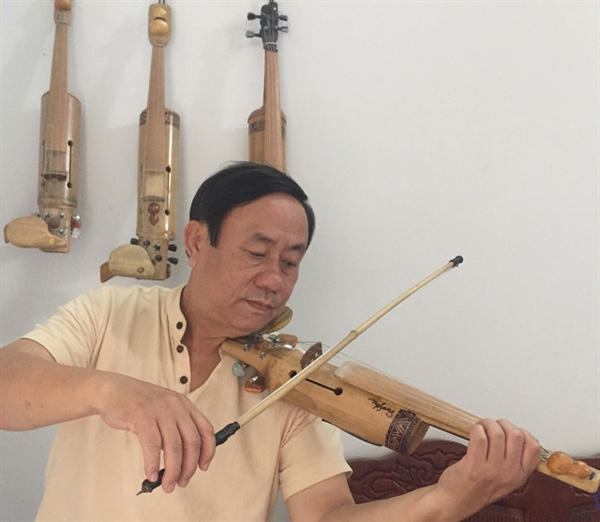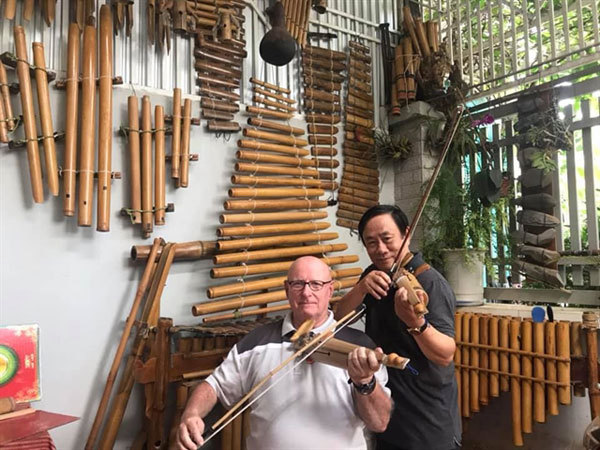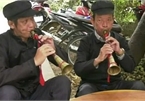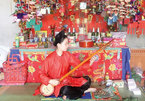 |
| Musician Nguyen Truong performs with his bamboo violin which he names viokram, Photo Vỹ Cầm Viokram Facebook |
Called the viokram - a combination of violin and kram, which is “bamboo” in the ethnic E De language - the instrument is lighter than a classical violin and produces the melodic sounds typical of the Central Highlands.
According to Truong, who is not only a musician but also a former lecturer in music at the Dak Lak College of Culture and Arts, the viokram is his latest creation and he spent a great deal of time on research before making it.
“The instrument is made of bamboo, a material abundant in nature,” he said.
“When played, it produces a sound resembling wind blowing through the forest or a bubbling stream, both of which are familiar yet strange at the same time.”
The creation of the viokram has enriched Truong’s collection of traditional musical instruments on display at his home.
His love for instruments such as the t’rưng, horns, and klông put are demonstrated by the way he keeps them neat and tidy in a corner of his home.
“My house has nothing of value except my collection of musical instruments, which is the result of years pursuing the traditional music of the ethnic people in the Central Highlands,” he said.
“Once you have fallen for it, you can’t get away from it.”
Despite his passion for traditional musical instruments, Truong studied a modern instrument - the violin - at the Hue National College of Music, now known as the Hue Academy of Music.
Upon graduating in 1980, he moved to Dak Lak to live and work, taking on positions such as music lecturer and manager of the training department at the Dak Lak College of Culture and Arts. This was when his interest in traditional musical instruments belonging to local ethnic minority groups began to blossom.
Working for more than 30 years in music teaching and training, he became experienced in sound absorption and boasts a rich knowledge of music, sounds, and vocals.
Not just able to build and play traditional musical instruments, Truong is also able to play a variety of modern instruments from the West, such as the violin and mandolin, which helps him come up with new ideas for his music.
When he retired, Truong took up the hobby of studying and collecting ethnic musical instruments in the Central Highlands. Among those he has collected, the most precious are buffalo horns that are hundreds of years old.
Most traditional musical instruments in the region, he explained, are made of bamboo, such as the t’rưng, đing clé, and the flute, which are limited in pitch and methods of playing.
 |
| Musician Truong is pictured with a foreign visitor who comes to his house to try playing viokram. Photo Vỹ Cầm Viokram Facebook |
With the goal of adding to the sounds of the Central Highlands, he came up with the idea of integrating traditional materials with a Western instrument, and the viokram was born.
“Part of the name viokram originates from the language of the E De, who occupy a large area of the Central Highlands,” he said. “It has four strings, tuned to E, A, D and G.”
“While classical violins are made from oak, which is both hard to find and expensive in Vietnam, the viokram is made of bamboo, which is virtually everywhere and much cheaper. It can also be made in different sizes, for both adults and children, and can be played either solo or within an orchestra.”
Despite the simplicity of the materials, making a viokram demands care and precision in chiselling and assembly in order to create the proper sound, he said.
According to musician Y San Alio, head of the Dak Lak Song and Dance Group, the viokram is indeed a unique creation.
“Using materials familiar in the Central Highlands, Truong has come up with an instrument that can produce the unique sound of the mountains and forests while also being suitable for playing with other instruments,” he said.
“Hopefully the viokram will find a place among the traditional musical instruments of the Central Highlands in particular and of Vietnam in general, contributing to preserving traditional music.”
The viokram has not yet been introduced widely to the public, and only Truong’s friends and local musicians know of its existence.
“Some foreigners visited recently and offered to buy it, but I’m not ready to sell to anyone just yet,” he said.
The creator of the bamboo violin also hosts music classes at his home, where he teaches local children how to play traditional musical instruments and also the viokram.
“I hope to pass on my passion for traditional music and instruments to the younger generation,” he added. VNS
by Luong Huong & Bao Trung

Pi Le panpipe, a traditional musical instrument of the Giay
The Giay in Bat Xat district, Lao Cai province, have a rich culture that includes music and musical instrument. The Pi Le clarinet is a typical woodwind instrument of the Giay.

Young girl follows family tradition to become a shaman
When most people hear the word shaman, they imagine a wizened old man with a long white beard. At just 17 years old, Lieu Thi Minh Tho defies all expectations, surprising everyone with her deep knowledge of rituals.
 His passion for traditional musical instruments from the Central Highlands inspired Nguyen Truong in the province of Dak Lak to come up with his own unique musical creation - a violin made from bamboo." itemprop="description" />
His passion for traditional musical instruments from the Central Highlands inspired Nguyen Truong in the province of Dak Lak to come up with his own unique musical creation - a violin made from bamboo." itemprop="description" />